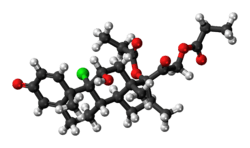Beclometasone dipropionate
|
 |
 |
|
|
| Systematic (IUPAC) name |
| (8S,9R,10S,11S,13S,14S,16S,17R)-9-chloro-11-hydroxy-10,13,16-trimethyl-3-oxo-17-[2-(propionyloxy)acetyl]-6,7,8,9,10,11,12,13,14,15,16,17-dodecahydro-3H-cyclopenta[a]phenanthren-17-yl propionate |
|
|
|
|
|
|
|
|
|
| Clinical data |
|
|
| AHFS/Drugs.com |
International Drug Names |
|
|
|
| Pregnancy cat. |
B3 (AU) |
| Legal status |
Pharmacy Only (S2) (AU) POM (UK) |
|
| Routes |
Oral & nasal inhalation, topical |
| Pharmacokinetic data |
| Bioavailability |
Converted to beclometasone-17-monopropionate (17-BMP) during absorption |
| Protein binding |
87% of 17-BMP to albumin and transcortin |
| Metabolism |
By esterase enzymes found in most tissues |
| Half-life |
2.8 hours |
| Excretion |
? |
| Identifiers |
| CAS number |
5534-09-8  Y Y |
| ATC code |
A07EA07 D07AC15, R01AD01, R03BA01 |
| PubChem |
CID 21700 |
|
| DrugBank |
DB00394 |
| ChemSpider |
20396  Y Y |
| UNII |
5B307S63B2  Y Y |
|
| ChEBI |
CHEBI:3002  Y Y |
| ChEMBL |
CHEMBL1200500  N N |
|
|
|
| Chemical data |
| Formula |
C28H37ClO7 |
| Mol. mass |
521.042 g/mol |
SMILES
- O=C(OCC(=O)[C@]3(OC(=O)CC)[C@]2(C[C@H](O)[C@]4(Cl)[C@@]/1(\C(=C/C(=O)\C=C\1)CC[C@H]4[C@@H]2C[C@@H]3C)C)C)CC
|
InChI=1S/C28H37ClO7/c1-6-23(33)35-15-22(32)28(36-24(34)7-2)16(3)12-20-19-9-8-17-13-18(30)10-11-25(17,4)27(19,29)21(31)14-26(20,28)5/h10-11,13,16,19-21,31H,6-9,12,14-15H2,1-5H3/t16-,19-,20-,21-,25-,26-,27-,28-/m0/s1  Y Y
Key:KUVIULQEHSCUHY-XYWKZLDCSA-N  Y Y
|
|
|
|
|
|
|
|
 N (what is this?) (verify) N (what is this?) (verify) |
|
Beclometasone dipropionate (INN modified) or beclomethasone dipropionate (USAN, former BAN) is a potent glucocorticoid steroid. It is a prodrug of the free form, beclometasone (INN). In the form of an inhaler (e.g. Clenil, Qvar), a wide number of brands of which are available, it is used for the prophylaxis of asthma. As a nasal spray (e.g. Beconase, alanase, Vancenase) or nasal aerosol (e.g. Qnasl), it is used for the treatment of rhinitis (e.g. hay fever) and sinusitis. In some instances, it is used by oral pathologists in the treatment of unusually severe aphthous ulcers.
As a cream or ointment (trade name Propaderm), it is used to treat severe inflammatory skin disorders (e.g. eczema) unresponsive to less potent steroids, but is generally avoided in the treatment of psoriasis due to the risk of rebound on withdrawal.
It is also licensed to treat ulcerative colitis in conjunction with doses of 5-aminosalicylates in the United Kingdom in the form of a gastric acid-resistant, periodic release tablet marketed under the brand name Clipper.
Chemistry
It is a white to creamy-white, odorless powder which is very slightly soluble in water, very soluble in chloroform, and freely soluble in acetone and in ethanol.
Side effects
Occasionally it may cause a cough upon inhalation. Deposition on the tongue and throat may promote oral candidiasis, which appears as a white coating, possibly with irritation.[1][2][3]
This may usually be prevented by rinsing the mouth with water after using the inhaler. Other side effects may rarely include: a smell similar to burning plastic, unpleasant taste, hoarseness or nasal congestion, pain or headache and visual changes. Allergic reactions may occur, but rarely.
Nasal corticosteroids may be associated with central serous retinopathy.[4]
See also
References
- ↑ Willey R, Milne L, Crompton G, Grant I (1976). "Beclomethasone dipropionate aerosol and oropharyngeal candidiasis". Br J Dis Chest 70 (1): 32–8. doi:10.1016/0007-0971(76)90004-8. PMID 1259918.
- ↑ Salzman G, Pyszczynski D (1988). "Oropharyngeal candidiasis in patients treated with beclomethasone dipropionate delivered by metered-dose inhaler alone and with Aerochamber". J Allergy Clin Immunol 81 (2): 424–8. doi:10.1016/0091-6749(88)90911-6. PMID 3339197.
- ↑ Fukushima C, Matsuse H, Tomari S, Obase Y, Miyazaki Y, Shimoda T, Kohno S (2003). "Oral candidiasis associated with inhaled corticosteroid use: comparison of fluticasone and beclomethasone". Ann Allergy Asthma Immunol 90 (6): 646–51. doi:10.1016/S1081-1206(10)61870-4. PMID 12839324.
- ↑ Haimovici R, Gragoudas ES, Duker JS, Sjaarda RN, Eliott D (October 1997). "Central serous chorioretinopathy associated with inhaled or intranasal corticosteroids". Ophthalmology 104 (10): 1653–60. PMID 9331207.
|
|---|
| | Rehydration | |
|---|
| | Intestinal anti-infectives | |
|---|
| | Intestinal adsorbents | |
|---|
| | Antipropulsives (opioids) | |
|---|
| | Intestinal anti-inflammatory agents |
- antiallergic agents, excluding corticosteroids
|
|---|
| | Antidiarrheal micro-organisms | |
|---|
| | Other antidiarrheals | |
|---|
|
|
anat (t, g, p)/phys/devp/enzy
|
noco/cong/tumr, sysi/epon
|
proc, drug (A2A/2B/3/4/5/6/7/14/16), blte
|
|
|
|
|
|---|
| | Topical |
Sympathomimetics, plain | |
|---|
| | |
|---|
| | |
|---|
| Other nasal preparations | |
|---|
|
|---|
| Systemic use:
Sympathomimetics | |
|---|
|
|
anat (n, x, l, c)/phys/devp
|
noco (c, p)/cong/tumr, sysi/epon, injr
|
proc, drug (R1/2/3/5/6/7)
|
|
|
|
|
|---|
| Mineralocorticoids
(3-one, 4-ene,
no FG at 16) | |
|---|
| Glucocorticoids
(3-one, 4-ene,
11-FG,
17-hydroxy) |
| |
|---|
| | |
|---|
| | |
|---|
| Pregnadienediol
(+21-hydroxy) | |
|---|
| Pregnadienetriol
(+11-hydroxy) | |
|---|
| | |
|---|
| | |
|---|
| Other/ungrouped | |
|---|
|
|---|
| | Aldosterone antagonists | |
|---|
| | Synthesis modifiers | |
|---|
| | |
| |
noco (d)/cong/tumr, sysi/epon
|
proc, drug (A10/H1/H2/H3/H5)
|
|
|
|
|
|---|
| | Subsidiaries | |
|---|
| Predecessors and fully
integrated acquisitions | |
|---|
| Products
(List) |
Current |
Pharmaceuticals | |
|---|
| Vaccines | |
|---|
| Other | |
|---|
|
|---|
| Former | |
|---|
|
|---|
| | People |
|
|---|
| | Other | |
|---|
| |
|

